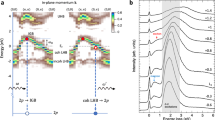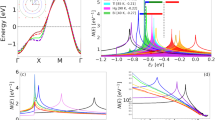Abstract
In the high-temperature (Tc) cuprate superconductors, a growing body of evidence suggests that the pseudogap phase1, existing below the pseudogap temperature T∗, is characterized by some broken electronic symmetries distinct from those associated with superconductivity2,3,4,5,6,7,8,9,10,11,12,13,14,15,16,17,18,19,20,21. In particular, recent scattering experiments have suggested that charge ordering competes with superconductivity18,19,20,21. However, no direct link of an interplay between the two phases has been identified from the important low-energy excitations. Here, we report an antagonistic singularity at Tc in the spectral weight of Bi2Sr2CaCu2O8+δ as compelling evidence for phase competition, which persists up to a high hole concentration p ~ 0.22. Comparison with theoretical calculations confirms that the singularity is a signature of competition between the order parameters for the pseudogap and superconductivity. The observation of the spectroscopic singularity at finite temperatures over a wide doping range provides new insights into the nature of the competitive interplay between the two orders and the complex phase diagram near the pseudogap critical point.
This is a preview of subscription content, access via your institution
Access options
Subscribe to this journal
Receive 12 print issues and online access
$259.00 per year
only $21.58 per issue
Buy this article
- Purchase on Springer Link
- Instant access to full article PDF
Prices may be subject to local taxes which are calculated during checkout




Similar content being viewed by others
References
Hüfner, S., Hossain, M. A., Damascelli, A. & Sawatzky, G. A. Two gaps make a high-temperature superconductor? Rep. Prog. Phys. 71, 062501 (2008).
Ando, Y., Segawa, K., Komiya, S. & Lavrov, A. N. Electrical resistivity anisotropy from self-organized one dimensionality in high-temperature superconductors. Phys. Rev. Lett. 88, 137005 (2002).
Vershinin, M. et al. Local ordering in the pseudogap state of the high-Tc superconductor Bi2Sr2CaCu2O8+δ . Science 303, 1995–1998 (2004).
Fauque, B. et al. Magnetic order in the pseudogap phase of high-Tc superconductors. Phys. Rev. Lett. 96, 197001 (2006).
Kohsaka, Y. et al. An intrinsic bond-centered electronic glass with unidirectional domains in underdoped cuprates. Science 315, 1380–1385 (2007).
Hinkov, V. et al. Electronic liquid crystal state in the high-temperature superconductor YBa2Cu3O6.45 . Science 319, 597–600 (2008).
Li, Y. et al. Unusual magnetic order in the pseudogap region of the superconductor HgBa2CuO4+δ . Nature 455, 372–375 (2008).
Ma, J. H. et al. Coexistence of competing orders with two energy gaps in real and momentum space in the high temperature superconductor Bi2Sr2−xLaxCuO6+δ . Phys. Rev. Lett. 101, 207002 (2008).
Mook, H. A., Sidis, Y., Fauqué, B., Balédent, V. & Bourges, P. Observation of magnetic order in a superconducting YBa2Cu3O6.6 single crystal using polarized neutron scattering. Phys. Rev. B 78, 020506 (2008).
Xia, J. et al. Polar Kerr-effect measurements of the high-temperature YBa2Cu3O6+x superconductor: Evidence for broken symmetry near the pseudogap temperature. Phys. Rev. Lett. 100, 127002 (2008).
Daou, R. et al. Broken rotational symmetry in the pseudogap phase of a high-Tc superconductor. Nature 463, 519–522 (2010).
Hashimoto, M. et al. Particle–hole symmetry breaking in the pseudogap state of Bi2201. Nature Phys. 6, 414–418 (2010).
Lawler, M. J. et al. Intra-unit-cell electronic nematicity of the high-Tc copper-oxide pseudogap states. Nature 466, 347–351 (2010).
Parker, C. V. et al. Fluctuating stripes at the onset of the pseudogap in the high-Tc superconductor Bi2Sr2CaCu2O8+x . Nature 468, 677–680 (2010).
He, R. H. et al. From a single-band metal to a high-temperature superconductor via two thermal phase transitions. Science 331, 1579–1583 (2011).
Shekhter, A. et al. Bounding the pseudogap with a line of phase transitions in YBa2Cu3O6+δ . Nature 498, 75–77 (2013).
Tranquada, J. M., Sternlieb, B. J., Axe, J. D., Nakamura, Y. & Uchida, S. Evidence for stripe correlations of spins and holes in copper-oxide superconductors. Nature 375, 561–563 (1995).
Ghiringhelli, G. et al. Long-range incommensurate charge fluctuations in (Y, Nd)Ba2Cu3O6+x . Science 337, 821–825 (2012).
Chang, J. et al. Direct observation of competition between superconductivity and charge density wave order in YBa2Cu3O6.67 . Nature Phys. 8, 871–876 (2012).
Comin, R. et al. Charge order driven by Fermi-arc instability in Bi2Sr2−xLaxCuO6+δ . Science 343, 390–392 (2014).
Da Silva Neto, E. H. et al. Ubiquitous interplay between charge ordering and high-temperature superconductivity in cuprates. Science 343, 393–396 (2014).
Eschrig, M. & Norman, M. R. Neutron resonance: Modeling photoemission and tunneling data in the superconducting state of Bi2Sr2CaCu2O8+δ . Phys. Rev. Lett. 85, 3261–3264 (2000).
Cuk, T. et al. Coupling of the B1g phonon to the antinodal electronic states of Bi2Sr2Ca0.92Y0.08Cu2O8+δ . Phys. Rev. Lett. 93, 117003 (2004).
Devereaux, T. P. & Hackl, R. Inelastic light scattering from correlated electrons. Rev. Mod. Phys. 79, 175–233 (2007).
Vishik, I. M. et al. Phase competition in trisected superconducting dome. Proc. Natl Acad. Sci. USA 109, 18332–18337 (2012).
Feng, D. L. et al. Signature of superfluid density in the single-particle excitation spectrum of Bi2Sr2CaCu2O8+δ . Science 289, 277–281 (2000).
Anzai, H. et al. Relation between the nodal and antinodal gap and critical temperature in superconducting Bi2212. Nature Commun. 4, 1815 (2013).
Zheng, G. Q., Kuhns, P. L., Reyes, A. P., Liang, B. & Lin, C. T. Critical point and the nature of the pseudogap of single-layered copper-oxide Bi2Sr2−xLaxCuO6+δ superconductors. Phys. Rev. Lett. 94, 047006 (2005).
Tallon, J. L., Loram, J. W., Cooper, J. R., Panagopoulos, C. & Bernhard, C. Superfluid density in cuprate high-Tc superconductors: A new paradigm. Phys. Rev. B 68, 180501 (2003).
Anukool, W., Barakat, S., Panagopoulos, C. & Cooper, J. R. Effect of hole doping on the London penetration depth in Bi2.15Sr1.85CaCu2O8+δ and Bi2.1Sr1.9Ca0.85Y0.15Cu2O8+δ . Phys. Rev. B 80, 024516 (2009).
Moon, E. G. & Sachdev, S. Quantum critical point shifts under superconductivity: Pnictides and cuprates. Phys. Rev. B 82, 104516 (2010).
Wu, T. et al. Magnetic-field-induced charge-stripe order in the high-temperature superconductor YBa2Cu3Oy . Nature 477, 191–194 (2011).
Doiron-Leyraud, N. et al. Quantum oscillations and the Fermi surface in an underdoped high-Tc superconductor. Nature 447, 565–568 (2007).
Yu, L. et al. Evidence for two separate energy gaps in underdoped high-temperature cuprate superconductors from broadband infrared ellipsometry. Phys. Rev. Lett. 100, 177004 (2008).
Tallon, J. L., Bernhard, C., Shaked, H., Hitterman, R. L. & Jorgensen, J. D. Generic superconducting phase behavior in high-Tc cuprates: Tc variation with hole concentration in YBa2Cu3O7−δ . Phys. Rev. B 51, 12911–12914 (1995).
Feng, D. L. et al. Electronic excitations near the Brillouin zone boundary of Bi2Sr2CaCu2O8+δ . Phys. Rev. B 65, 220501 (2002).
Acknowledgements
We thank S. Kivelson, H. Yao, A. Millis, D. Scalapino, P. Hirshfeld, B. Markiewicz, D-H. Lee, L. Yu, A. Fujimori and N. Nagaosa for fruitful discussions. ARPES experiments were performed at the Stanford Synchrotron Radiation Lightsource, operated by the Office of Basic Energy Science, US DOE. This work is supported by DOE Office of Basic Energy Sciences, Materials Sciences and Engineering Division, under Contract DE-AC02-76SF00515.
Author information
Authors and Affiliations
Contributions
M.H., T.P.D. and Z-X.S. conceived the experiment. M.H., R-H.H., I.M.V., Y.H. and K.T. carried out ARPES measurements with the assistance of D.L. and R.G.M. M.H. analysed the data. Y.Y., M.I., T.S., K.F. and S.I. synthesized and characterized bulk single crystals. E.A.N., B.M. and T.P.D. performed theoretical calculations. All authors contributed to the scientific planning and discussions.
Corresponding authors
Ethics declarations
Competing interests
The authors declare no competing financial interests.
Supplementary information
Supplementary Information
Supplementary Information (PDF 2294 kb)
Rights and permissions
About this article
Cite this article
Hashimoto, M., Nowadnick, E., He, RH. et al. Direct spectroscopic evidence for phase competition between the pseudogap and superconductivity in Bi2Sr2CaCu2O8+δ. Nature Mater 14, 37–42 (2015). https://doi.org/10.1038/nmat4116
Received:
Accepted:
Published:
Issue Date:
DOI: https://doi.org/10.1038/nmat4116
This article is cited by
-
Unveiling phase diagram of the lightly doped high-Tc cuprate superconductors with disorder removed
Nature Communications (2023)
-
Fate of charge order in overdoped La-based cuprates
npj Quantum Materials (2023)
-
Unconventional spectral signature of Tc in a pure d-wave superconductor
Nature (2022)
-
Fluctuation induced conductivity and pseudogap state studies of Bi1.6Pb0.4Sr2Ca2Cu3O10+δ superconductor added with ZnO nanoparticles
Scientific Reports (2021)
-
A picture of pseudogap phase related to charge fluxes
npj Computational Materials (2020)



